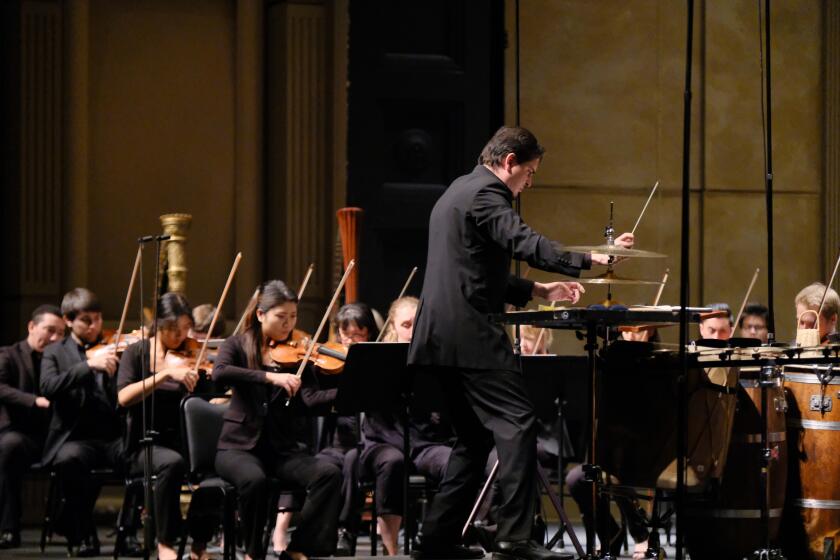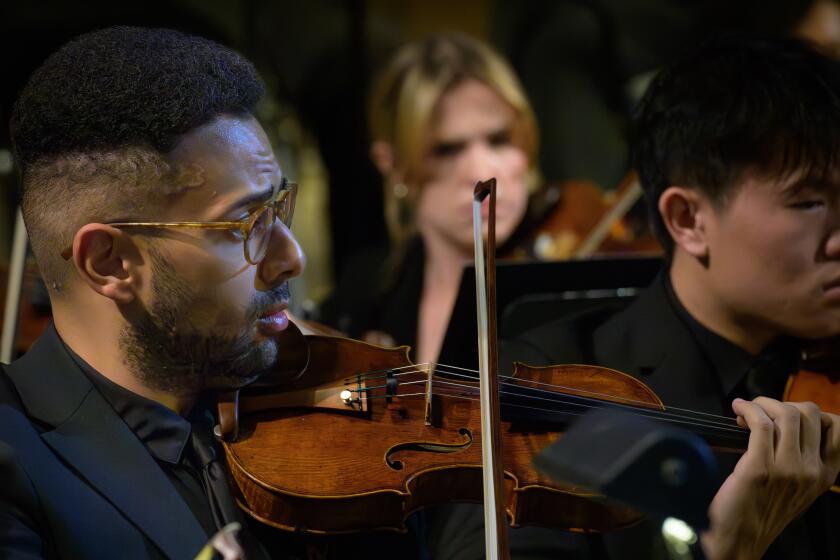That’s one giant LEAP for dancers
Valerie-Jean Miller was 3 when the Florida toddler began picking up vaudeville routines from her father, a onetime song-and-dance man.
“He taught me all his hoofin’ steps. I was totally hooked,” Miller says. “I watched ‘The Jackie Gleason Show’ and would do things along with everyone. When I was 13, Gleason moved the show down to Miami, and five years later I got a job working with [show choreographer] June Taylor. It was one of my first television jobs.
“I’ve worked professionally for about 25 years, all kinds of dance -- tap, commercial, theater, TV, movies -- everything except dancing without clothes on.”
Now, though, Miller is 54. She has danced only rarely for years. What to do?
Candy Brown Houston is a kindred spirit, though she calls herself -- with good reason -- “a Broadway girl.”
“I’ve done shows with Pearl Bailey, Cab Calloway, Bob Fosse, Hal Prince and Lester Wilson,” she explains. “I was in the original cast of ‘Pippin,’ ‘Chicago,’ ‘Grind,’ ‘Chorus Line’ -- the original workshop. My story is still there. I’m still getting royalties from it.”
How old is she?
“I’m not giving you any numbers,” she says, laughing. “You can do the math.”
One evening at the Screen Actors Guild on Wilshire Boulevard, Miller and Houston are among some 20 current and former dancers, in their 20s to their mid-50s, sitting around a large conference table as part of an academic course called Personal and Professional Assessment. They’re members of the first Los Angeles class of LEAP -- Liberal Education for Arts Professionals. All are working toward bachelor’s degrees.
LEAP was created five years ago in San Francisco by Claire Sheridan, a former dancer whose career was sidelined when she was injured. But she had options she knew many other dancers didn’t have.
After she stopped performing, Sheridan says, “I would watch dancers rehearse and think, ‘This is a tragedy. They’re going to go through what I went through. They don’t have a degree, but I did.’ ”
Sheridan thought a good way to alleviate that situation would be an accelerated program of higher education tailored to the needs of working dancers. She took the idea to St. Mary’s College of California in Moraga, where she had taught and helped develop the dance program.
The college, which takes pride in its Lasallian Christian tradition of extending education to people who might not otherwise receive it, endorsed her idea. It set up classes once a week to fit dancers’ heavy performing, touring and rehearsal schedules and awarded credit for professional experience in ballet, modern, ethnic, jazz or tap.
Moreover, because Moraga is less than 20 miles east of San Francisco, the college offered the classes in the city, at a downtown location just a few blocks from the Franklin Street studios of San Francisco Ballet. The move drew a number of members of that company and other local troupes -- from corps dancers to principals -- to the classroom.
“There were a couple of professors who were snarling a bit,” Sheridan recalls. “They worried about the program being off-campus, not having a library right there. But the alternative is nothing. These dancers would never get to college.”
That’s the key point.
“I tried alternatives, and they didn’t work,” says Bill Szobody, a 37-year-old dancer who recently appeared in “Kiss Me, Kate” at the Carpenter Performing Arts Center in Long Beach and who also teaches dance at Pepperdine University in Malibu. “I tried to go to West Los Angeles College. I tried to go to Los Angeles City College. It just wasn’t a fit.
“First of all, it’s a whole age thing. That was hard. In LEAP, you get this personal attention from people who understand where you come from. At a big community college, you’re just another number, another person. You don’t get any attention or credit for all the work you’ve done in the past.”
Fear is another factor that keeps many dancers from pursuing higher education.
“I was definitely scared about going back to school, by the paperwork and the homework,” says Shaneca Adams, 28, who recently joined the Blue Man Group troupe in New York. “But a dancer has a limited life span, and it’s really important to get other knowledge and study other things.”
Even dancers who have starred in the limelight can doubt their skills outside it.
“You have to write English,” says San Francisco Ballet principal Yuan Yuan Tan, 28, who will get her degree next year. “I can speak it OK, but not for writing. The first one or two essays, I didn’t know what to do. American students can write one essay in two or three hours. I’m sure I take double time.
“But if I don’t get it right, I just write in Chinese because I don’t want to stop my thoughts. I can think in English, ‘one, two, three,’ then ‘four, five, six’ in Chinese, but I don’t want to stop.”
The problem for most dancers is that they go straight from high school to professional companies after having already devoted half their lives to perfecting their physical skills. Once employed, they typically work six days a week, which rules out traditional college classes. When it’s time to retire, the experience can be traumatic.
“Lots of dancers go into hiding after they’re finished,” says Joanne DiVito, administrator for Career Transition for Dancers, a New York and Los Angeles-based support organization. “They’re so ashamed that they couldn’t continue.
“There’s a dark side to this transition. One dancer became homeless; another became an alcoholic. Our community already has problems with painkillers and, obviously, eating disorders. All that is taken care of here. It’s very confidential. We’ve helped hundreds of dancers. But I realized that a lot of dancers needed to get their education.”
Indeed, Career Transitions had already helped Broadway veteran Houston shift from dancing to acting.
“I was doing pretty well,” she says. “But as the years rolled on, it became more and more difficult for women over 40. The jobs weren’t coming. I have to transition to something else.”
With a bachelor’s in hand, Houston will be able to go on to graduate school or pursue a better-paying job than might otherwise be available to her. LEAP alumni have become teachers, dance coaches, physical therapists and trainers. One is a minister.
DiVito, who helped bring the program to L.A., is also a LEAP student. It took her about 2 1/2 years to get the program here. Sheridan was concerned about spreading herself too thin and also maintaining quality control.
Affordability for dancers
Sheridan, like other instructors, does fly from the Bay Area every week for the L.A. classes, but she’s eased her burden since passing administrative tasks to Mark Baird, a former Joffrey Ballet dancer and LEAP student. Baird took over in 2002. Sheridan now oversees independent studies and senior projects.
Together, working with St. Mary’s, the two have managed to keep costs reasonably low. The three-year program runs $16,860, which by current academic standards is quite a bargain.
“It has to be low,” Baird says. “For the most part, dancers don’t have a lot of money.”
But teachers, it seems, feel protective toward these students.
“They tend to be very hard on themselves,” says Kathleen Taylor, who teaches the personal and professional assessment class in L.A. “They tend to be perfectionists because of their craft, their art. When they’re in school, they’re still working from that frame. So they’re unnecessarily hard on themselves. It’s important to tell them you don’t learn perfectly. Learning is about ambiguity.”
Dance companies, for their part, seem to love the program.
“We were always concerned about what happens to dancers after they leave us,” San Francisco Ballet executive director Glenn McCoy says. “We weren’t sure how to fix the problems. We instituted more than 15 years ago something we call the ‘artist reserve fund,’ from which we award grants for training purposes. Most of that is now going to LEAP tuition.
“Other companies have tried to do a number of different things, from resume writing workshops to career counseling. In every ballet company, there’s a lot of discussion about career transitioning. This is the most effective thing I’ve seen.”
One major reason for that may be that LEAP bends over backward to help students. When Adams was invited to join Blue Man Group six weeks into the L.A. program, he thought he’d have to drop out.
“But Mark and the dean really came together to help me finish the class through correspondence,” he says. “I would call in. I did the last three sessions over a speakerphone, three or four hours on the phone. The way the program is set up, I can do classes online until I get back into an actual classroom setting or I’m back in L.A. They’re really working hard to keep me from not dropping out.”
More to Read
The biggest entertainment stories
Get our big stories about Hollywood, film, television, music, arts, culture and more right in your inbox as soon as they publish.
You may occasionally receive promotional content from the Los Angeles Times.






